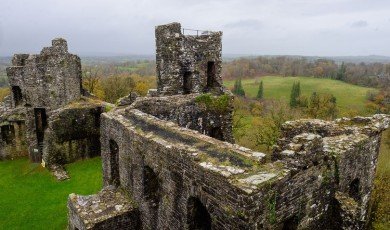
Castles in Wales are an enduring symbol of the country's rich and complex history. From towering medieval fortresses to sprawling Tudor mansions, Wales boasts a wealth of architectural treasures that tell the story of its past.
In this blog post, we'll take a closer look at some of the most notable castles in Wales, exploring their history, design, and cultural significance. From the imposing walls of Caernarfon to the romantic ruins of Tintern, these castles offer a glimpse into a fascinating and often turbulent chapter in Welsh history.
Wales is home to some of the most fascinating castles in the world. From the imposing walls of Caernarfon to the fairy-tale turrets of Conwy, Wales boasts a rich history of fortifications and battles. In this blog post, we will explore ten of the most impressive castles in Wales, their histories, and what makes them worth a visit.
1.Caernarfon Castle
One of the most iconic castles in Wales, Caernarfon Castle is a testament to the military might of King Edward I, who built it in the late 13th century. The castle is situated in the town of Caernarfon, on the banks of the Menai Strait, and was designed to be a symbol of English domination over the Welsh.Located in the northern part of Wales, Caernarfon Castle is one of the most well-known castles in the country. Built by King Edward I in the late 13th century, it was designed as a symbol of his power and authority over the Welsh people. Today, the castle is a UNESCO World Heritage site and is open to the public for tours and events.
Caernarfon Castle is a classic example of the concentric castle design, with a series of walls and towers surrounding a central courtyard. The castle's massive stone walls, which are up to 18 feet thick in places, were designed to withstand siege warfare, and the imposing gatehouses and towers were meant to intimidate potential attackers.
Despite its fearsome appearance, Caernarfon Castle also served as a royal palace and was the site of the investiture of Prince Charles as the Prince of Wales in 1969. Today, the castle is a popular tourist attraction, with guided tours and special events throughout the year.
2.Conwy Castle
Located in the town of Conwy, on the north coast of Wales, Conwy Castle is another impressive example of Edward I's military engineering. The castle was built in the late 13th century as part of a series of fortifications designed to secure English control over Wales.
Like Caernarfon, Conwy Castle is a concentric castle, with a series of walls and towers surrounding a central courtyard. The castle's design is particularly innovative, with numerous defensive features such as arrow slits, murder holes, and portcullises.
Today, Conwy Castle is one of the best-preserved medieval fortresses in Europe, and is a UNESCO World Heritage site. Visitors can explore the castle's battlements and towers, and enjoy panoramic views of the town and surrounding landscape.
Another impressive fortress in the north of Wales, Conwy Castle was also built by Edward I in the 13th century. It is known for its fairy-tale appearance, with turrets and towers overlooking the town of Conwy. Visitors can climb to the top of the towers for panoramic views of the surrounding countryside.
3.Harlech Castle
Built in the late 13th century, Harlech Castle is another example of Edward I's ambitious military building program. The castle is located on the west coast of Wales, overlooking Cardigan Bay, and was designed to guard the strategic route between North and South Wales.
Harlech Castle is a large and imposing structure, with high curtain walls and imposing gatehouses. The castle's location on a rocky outcrop makes it particularly difficult to attack, and the design includes several ingenious defensive features such as a drawbridge and a system of underground tunnels.
During the Wars of the Roses, Harlech Castle was held by Lancastrian forces, and was besieged by Yorkist armies for seven years. The siege was ultimately unsuccessful, and the castle remained in Lancastrian hands until the end of the conflict. Today, visitors can explore the castle's impressive walls and towers, and learn about its rich and fascinating history.
4.Raglan Castle
Located in the county of Monmouthshire, in southeast Wales, Raglan Castle is a stunning example of Tudor architecture. The castle was built in the late 15th century by Sir William Herbert, a wealthy Welsh nobleman who was one of the most powerful figures in the country at the time.
Raglan Castle is a symmetrical and highly decorative structure, with a mix of Gothic and Renaissance elements.
Located in the southeast of Wales, Raglan Castle is known for its impressive Gothic architecture and its role in the English Civil War. Built in the 15th century, it was one of the last castles to fall during the war. Visitors can explore the castle's ruins and see the impressive Great Tower, which was once one of the tallest structures in Wales.
5.Cardiff Castle
Located in the heart of the capital city, Cardiff Castle has a long and fascinating history. It was originally a Roman fort and was later transformed into a Norman castle in the 11th century. Over the centuries, it has been expanded and renovated many times, and today it is a popular tourist attraction with a museum, guided tours, and events.
6.Pembroke Castle
Built in the 11th century, Pembroke Castle is one of the oldest castles in Wales. It was the birthplace of Henry VII, the first Tudor king, and played a significant role in the Wars of the Roses. Today, the castle is open to the public and offers guided tours and events.








